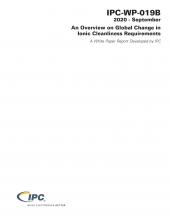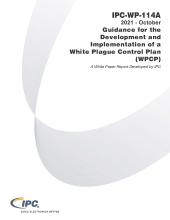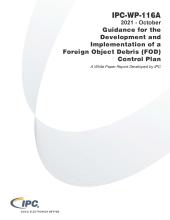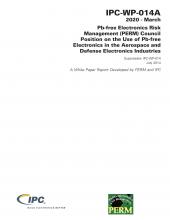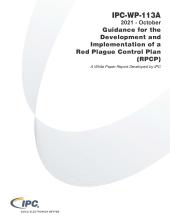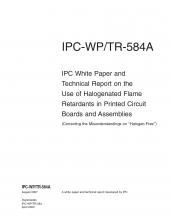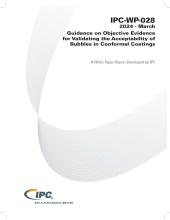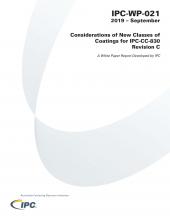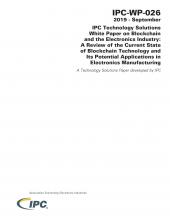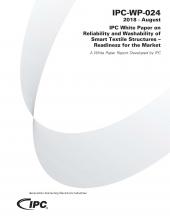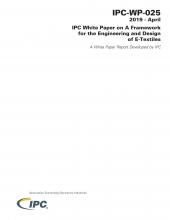Your results
- 62
Document #
Language
Products
The IPC-WP-019B white paper was created to support the IPC-J-STD-001H standard and provides additional guidance, examples, and understanding of Section 8.0 Cleaning and Residue Requirements. The IPC-WP-019B has information on how to meet the requirements of IPC-J-STD-001H chapter 8. Recommentded for those looking to implement the requirements of IPC-J-STD-001H standard, chapter 8. 0..
The IPC-WP-114A white paper provides guidance to reduce and control exposure to environmental conditions and contamination that promote the development of White Plague. A template for developing a White Plague Control Plan (WPCP) is included.
The IPC-WP-116A white paper provides guidance to control and mitigate risks associated with the introduction of Foreign Object Debris (FOD) in electrical and electronic assemblies. Guidance to control and mitigate risks associated with the introduction of Foreign Object Debris (FOD) in electrical and electronic assemblies is provided. A template for developing a Foreign Object Debris (FOD) Control...
Pb-free materials are considered a major technology disruption to traditional Pb-based interconnect materials for electronics, which is of particular concern for the aerospace & defense industries where safety cannot be compromised and applicable reliability data remains scarce. Until validated data and modelling methods are developed, projects considering Pb-free Aerospace & Defense products and...
The IPC-WP-113A white paper provides guidance to reduce and control exposure to environmental conditions and contamination that promote the development of Red Plague. A template for developing a Red Plague Control Plan (RPCP) is included.
This document summarizes the IPC position on the subject of “halogen-free” materials for the electronics industry. Its initial release was developed over a period of three years and this revision is also the culmination of another three years of work by a team representing every level of the electronics supply chain. This document is applicable to materials for interconnecting electronics...
IPC-WP-028 white paper provides guidance on obtaining objective evidence for validating the acceptability of bubbles in conformal coatings. It focuses on a failure mode where bubbles in coatings could activate a microclimate involving condensation of humidity inside the bubbles resulting in an increase of the local humidity load to a critical level, thus generating electrochemical migration...
Due to a concern in the electronic packaging industry about solderability problems, Foster Gray, PC Interconnects, developed this document for the Surface Mount Council. Areas covered are: design for the soldering process; solderable PWBs; solderable components and soldering process. Five different industry perspectives provide analysis of these issues. 35 pages. Released August 1991.
Lead-free electronics continues to be a concern of the aerospace, defense, and high performance products (ADHP) industries. This is primarily due to the lack of data and knowledge to: thoroughly categorize performance under harsh service conditions and provide a level of confidence in reliability assessments of Pb-free electronics equal to those for traditional tin-lead electronics. To help close...
The PERM Lead-Free Manhattan Project (LFMP) was established to identify the technology and knowledge gaps relevant to the implementation of commercially available Pb-free product in Aerospace & Defense Systems. These knowledge gaps threaten to affect the safety, performance and reliability of Aerospace & Defense systems, which cannot be compromised. Investment is required to close these knowledge...
IPC-WP-023 is an IPC Technology Solutions White Paper addressing reliability issues associated with stacked microvias. There is evidence that staggering vias can result in a more robust structure; however, staggering microvias is only a temporary solution to accommodate complex designs with microvias built with weak interface structures IPC-WP-023 white paper provides an investigation of these...
The IPC-WP-021 white paper considers conformal coatings, like many high-performance materials, have evolved considerably since the 1990s. New coatings, such as fluoropolymers or hybrid coatings, have come on the market, many of which offer superior protection characteristics, but do not fit into the existing classifications of either MIL-I-46058 or IPC-CC-830. The IPC-WP-021 white paper discusses...
The IPC-WP-026 white paper explores blockchain as an emerging technology that has a core strength in providing an immutable, auditable, transparent and secure environment for data exchanges. These advantages make it a prime candidate for implementation in the electronics industry. The IPC-WP-026 white paper explores blockchain and its limitations and challenges. It also provides a few directions...
IPC-WP-024 is a white paper which discusses the issues associated with reliability of smart textiles (e-textiles structures) following multiple washing cycles and emphasizes efforts that industry and research laboratories must undertake to make e-textile structures more robust and able to be washed similarly to everyday textile products (e.g., underwear, clothing, home textiles and technical...
Manufacturers of high reliability electronics have been working for many years to mitigate the deleterious effects of tin whisker formation. One highly effective means to suppress the growth of tin whiskers is to replace the pure tin plating with reflowed tin-lead solder. One approach is to fully consume the tin plating by tin-lead solder during the SMT reflow process. This phenomenon of tin...
This white paper is a benchmarking exercise of e-textile integrations, providing an introductory categorization of how the current market sector is using textile-based electrical components to achieve integrated functionality. This peer assessment provides a baseline understanding of e-textile process techniques, requirements and resources within this emerging sector.
This presentation "Trends in Military Certifications: What You Need to Know About the Obvious and the Obscure," was presented at the IPC Conference for the North American EMS Industry, What it Takes to Supply the Military, Management Session, in September 2010 by Steve DeWaters, president of Penumbra Strategies, Inc. It describes the rise of Commercial Off the Shelf (COTS) items and why Military...
This specification sets requirements based on performance criteria for the use of Immersion Silver (IAg) as a surface finish for printed circuit boards. It is intended for use by chemical suppliers, printed board manufacturers, electronics manufacturing services (EMS) companies and original equipment manufacturers (OEM). IAg is a thin immersion deposit over copper. It is a multifunctional surface...
Addresses the complete process of reengineering new product development processes to incorporate DFX methodologies. Presents the case for a comprehensive analysis of the key business issues and definition of requirements before initiating work to refine or restructure processes. Editor, Dieter Bergman, IPC. 88 pages. Released by the Surface Mount Council, April 1997.
Status of the technology discussion on the various methodologies for mounting and interconnecting active devices to a variety of substrate materials is summarized in this document. Reviews mounting techniques of tape automated bonding (TAB), chip on board (COB) and flip chip. Examinations of the most commonly used substrate options of laminate, ceramic and silicon are also reviewed. Editor: John...
This paper "Long Term Investigation of Urethane Conformal Coating Against Tin Whisker Growth" was presented by Lyudmyla Panashchenko of NASA GSFC at the IPC Tin Whisker Conference, in December 2010. It describes the results of 11 years of aging of a conformal coat and its ability to inhibit tin whisker growth. It shows that whiskers continue to grow with time and how they may be constrained by the...
"Is Your RFP D.O. A." was presented at the IPC Conference for the PCB Industry: Critical Issues for the Military Market in December 2011 by Steve DeWaters, president, Penumbra Strategies, Inc. The author describes the procedures of the military in preparing an RFP and evaluating the proposals. He also describes the procedures to create an effective response to the RFP and some of the pitfalls of...
"Final Finish for Connectivity" was presented by George Milad of Uyemura International Corporation at the IPC Conference for the PCB Industry: Critical Issues for the Military Market, in December 2011. The author describes surface finishes applied to printed circuit boards to enhance their reliability, solderability, shelf life and the applicability to wire bonding. He also mentions the IPC...
"Embedded Capacitor Technology; Status, Opportunity and Challenges" was presented by John Andresakis, vice president of strategic technology, Oak-Mitsui at the IPC Conference for the PCB Industry: Critical Issues for the Military Market, Washington D.C., in December 2011.The author explains how the use of this technology improves the performance, reliability and assembly cost of printed boards and...
The IPC Solder Products Value Council’s Technical Subcommittee Report “Take Action Limits (TAL) for SAC305 Lead Free Soldering Processes Utilizing Solder Baths/Pots” reports on research on take action limits of solder pot contamination for SAC305 lead-free solder. As opposed to one maximum contamination level, the IPC SPVC opted to identify three action levels: Normal operation defined as the...
Coming Soon
IPC-7095E: Design and Assembly Process Implementation for Ball Grid Arrays (BGAs)
IPC-2294: Design Standard for Printed Electronics on Rigid Substrates
IPC-6904: Qualification and Performance Specifications for Printed Electronics on Rigid Substrates
J-STD-005B: Requirements for Soldering Pastes
IPC-4105: Specification for Metal Base Copper Clad laminates for Rigid Printed Boards
J-STD-004D: Requirements for Soldering Fluxes
IPC-4413: Specification for Finished Fabric Woven from Low Dk Glass for Printed Boards

